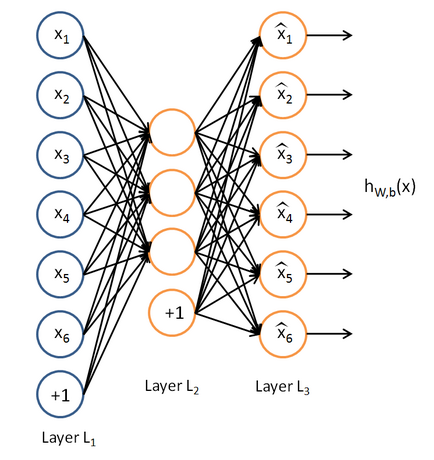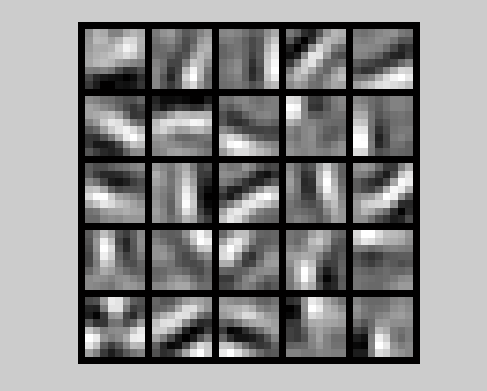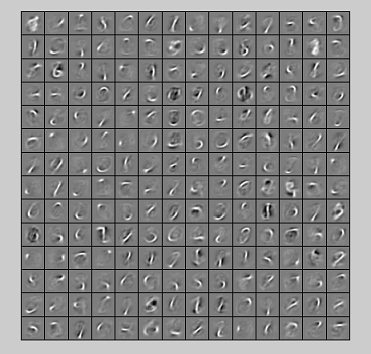原文作者:huiliao 原文链接:http://blog.csdn.net/freeliao/article/details/17967263
前言
看完神经网络及BP算法介绍后,这里做一个小实验,内容是来自斯坦福UFLDL教程,实现图像的压缩表示,模型是用神经网络模型,训练方法是BP后向传播算法。
理论
在有监督学习中,训练样本是具有标签的,一般神经网络是有监督的学习方法。我们这里要讲的是自编码神经网络,这是一种无监督的学习方法,它是让输出值等于自身来实现的。

从图中可以看到,神经网络模型只有一层隐含层,输出层跟输入层的神经单元个数是一样的。如果隐含层单元个数比输入层少的话,我们用这个模型学到的是
输入数据的压缩表示,相当于对输入数据进行降维(这是一种非线性的降维方法)。实际上,如果隐含层单元个数比输入层多,我们可以让隐含层的大部分单元激活值接近0,就是让它们稀疏,这样学到的也是压缩表示。我们模型要使得输出层跟输入层一样,就是隐含层要能够重建出跟输入层一样的输出层,这样我们学到的压缩表示才是有意义的。
回忆下之前介绍过的损失函数:

在这里,y是输出层,跟输入层是一样的。
自编码神经网络还增加了稀疏性惩罚一项。它是对隐含层进行了稀疏性的约束,即使得隐含层大部分值都处于非active状态。定义隐含层节点j的稀疏程度为

上式是对整个样本求隐含层节点j的平均值,如果是所有隐含层节点,那么就组成一个向量。
我们要设置期望隐含层稀疏性的程度,假设为
 ,因此我们希望对于所有的节点j
,因此我们希望对于所有的节点j
 。
。
 ,因此我们希望对于所有的节点j
,因此我们希望对于所有的节点j
 。
。
那怎么衡量实际跟期望的差别呢?

 实际上是关于伯努利变量p与q的
KL离散度(参考我之前写的关于信息熵的博客)。
实际上是关于伯努利变量p与q的
KL离散度(参考我之前写的关于信息熵的博客)。
此时损失函数为

由于加了稀疏项损失函数,对第二层节点求残差时公式变为

实验
实验教程是在
Exercise:Sparse Autoencoder,要实现的文件是
sampleIMAGES.m, sparseAutoencoderCost.m,computeNumericalGradient.m
实验步骤:
- 生成训练集
- 稀疏自编码目标函数
- 梯度校验
- 训练稀疏自编码
- 可视化
最后一步可视化是
 ,把x用图像表示出来的。
,把x用图像表示出来的。
 ,把x用图像表示出来的。
,把x用图像表示出来的。
代码如下:
sampleIMAGES.m
- <span style="font-size:14px;">function patches = sampleIMAGES()
- % sampleIMAGES
- % Returns 10000 patches for training
- load IMAGES; % load images from disk
- patchsize = 8; % we'll use 8x8 patches
- numpatches = 10000;
- % Initialize patches with zeros. Your code will fill in this matrix--one
- % column per patch, 10000 columns.
- patches = zeros(patchsize*patchsize, numpatches);
- %% ---------- YOUR CODE HERE --------------------------------------
- % Instructions: Fill in the variable called "patches" using data
- % from IMAGES.
- %
- % IMAGES is a 3D array containing 10 images
- % For instance, IMAGES(:,:,6) is a 512x512 array containing the 6th image,
- % and you can type "imagesc(IMAGES(:,:,6)), colormap gray;" to visualize
- % it. (The contrast on these images look a bit off because they have
- % been preprocessed using using "whitening." See the lecture notes for
- % more details.) As a second example, IMAGES(21:30,21:30,1) is an image
- % patch corresponding to the pixels in the block (21,21) to (30,30) of
- % Image 1
- [m,n,num] = size(IMAGES);
- for i=1:numpatches
- j = randi(num);
- bx = randi(m-patchsize+1);
- by = randi(n-patchsize+1);
- block = IMAGES(bx:bx+patchsize-1,by:by+patchsize-1,j);
- patches(:,i) = block(:);
- end
- %% ---------------------------------------------------------------
- % For the autoencoder to work well we need to normalize the data
- % Specifically, since the output of the network is bounded between [0,1]
- % (due to the sigmoid activation function), we have to make sure
- % the range of pixel values is also bounded between [0,1]
- patches = normalizeData(patches);
- end
- %% ---------------------------------------------------------------
- function patches = normalizeData(patches)
- % Squash data to [0.1, 0.9] since we use sigmoid as the activation
- % function in the output layer
- % Remove DC (mean of images).
- patches = bsxfun(@minus, patches, mean(patches));
- % Truncate to +/-3 standard deviations and scale to -1 to 1
- pstd = 3 * std(patches(:));
- patches = max(min(patches, pstd), -pstd) / pstd;
- % Rescale from [-1,1] to [0.1,0.9]
- patches = (patches + 1) * 0.4 + 0.1;
- end
- </span>
SparseAutoencoderCost.m
- <span style="font-size:14px;">function [cost,grad] = sparseAutoencoderCost(theta, visibleSize, hiddenSize, ...
- lambda, sparsityParam, beta, data)
- % visibleSize: the number of input units (probably 64)
- % hiddenSize: the number of hidden units (probably 25)
- % lambda: weight decay parameter
- % sparsityParam: The desired average activation for the hidden units (denoted in the lecture
- % notes by the greek alphabet rho, which looks like a lower-case "p").
- % beta: weight of sparsity penalty term
- % data: Our 64x10000 matrix containing the training data. So, data(:,i) is the i-th training example.
- % The input theta is a vector (because minFunc expects the parameters to be a vector).
- % We first convert theta to the (W1, W2, b1, b2) matrix/vector format, so that this
- % follows the notation convention of the lecture notes.
- W1 = reshape(theta(1:hiddenSize*visibleSize), hiddenSize, visibleSize);
- W2 = reshape(theta(hiddenSize*visibleSize+1:2*hiddenSize*visibleSize), visibleSize, hiddenSize);
- b1 = theta(2*hiddenSize*visibleSize+1:2*hiddenSize*visibleSize+hiddenSize);
- b2 = theta(2*hiddenSize*visibleSize+hiddenSize+1:end);
- % Cost and gradient variables (your code needs to compute these values).
- % Here, we initialize them to zeros.
- cost = 0;
- W1grad = zeros(size(W1));
- W2grad = zeros(size(W2));
- b1grad = zeros(size(b1));
- b2grad = zeros(size(b2));
- %% ---------- YOUR CODE HERE --------------------------------------
- % Instructions: Compute the cost/optimization objective J_sparse(W,b) for the Sparse Autoencoder,
- % and the corresponding gradients W1grad, W2grad, b1grad, b2grad.
- %
- % W1grad, W2grad, b1grad and b2grad should be computed using backpropagation.
- % Note that W1grad has the same dimensions as W1, b1grad has the same dimensions
- % as b1, etc. Your code should set W1grad to be the partial derivative of J_sparse(W,b) with
- % respect to W1. I.e., W1grad(i,j) should be the partial derivative of J_sparse(W,b)
- % with respect to the input parameter W1(i,j). Thus, W1grad should be equal to the term
- % [(1/m) \Delta W^{(1)} + \lambda W^{(1)}] in the last block of pseudo-code in Section 2.2
- % of the lecture notes (and similarly for W2grad, b1grad, b2grad).
- %
- % Stated differently, if we were using batch gradient descent to optimize the parameters,
- % the gradient descent update to W1 would be W1 := W1 - alpha * W1grad, and similarly for W2, b1, b2.
- %
- %矩阵向量化形式实现,速度比不用向量快得多
- Jcost = 0; %平方误差
- Jweight = 0; %规则项惩罚
- Jsparse = 0; %稀疏性惩罚
- [n, m] = size(data); %m为样本数,这里是10000,n为样本维数,这里是64
- %feedforward前向算法计算隐含层和输出层的每个节点的z值(线性组合值)和a值(激活值)
- %data每一列是一个样本,
- z2 = W1*data + repmat(b1,1,m); %W1*data的每一列是每个样本的经过权重W1到隐含层的线性组合值,repmat把列向量b1扩充成m列b1组成的矩阵
- a2 = sigmoid(z2);
- z3 = W2*a2 + repmat(b2,1,m);
- a3 = sigmoid(z3);
- %计算预测结果与理想结果的平均误差
- Jcost = (0.5/m)*sum(sum((a3-data).^2));
- %计算权重惩罚项
- Jweight = (1/2)*(sum(sum(W1.^2))+sum(sum(W2.^2)));
- %计算稀疏性惩罚项
- rho_hat = (1/m)*sum(a2,2);
- Jsparse = sum(sparsityParam.*log(sparsityParam./rho_hat)+(1-sparsityParam).*log((1-sparsityParam)./(1-rho_hat)));
- %计算总损失函数
- cost = Jcost + lambda*Jweight + beta*Jsparse;
- %反向传播求误差值
- delta3 = -(data-a3).*fprime(a3); %每一列是一个样本对应的误差
- sterm = beta*(-sparsityParam./rho_hat+(1-sparsityParam)./(1-rho_hat));
- delta2 = (W2'*delta3 + repmat(sterm,1,m)).*fprime(a2);
- %计算梯度
- W2grad = delta3*a2';
- W1grad = delta2*data';
- W2grad = W2grad/m + lambda*W2;
- W1grad = W1grad/m + lambda*W1;
- b2grad = sum(delta3,2)/m; %因为对b的偏导是个向量,这里要把delta3的每一列加起来
- b1grad = sum(delta2,2)/m;
- %%----------------------------------
- % %对每个样本进行计算, non-vectorial implementation
- % [n m] = size(data);
- % a2 = zeros(hiddenSize,m);
- % a3 = zeros(visibleSize,m);
- % Jcost = 0; %平方误差项
- % rho_hat = zeros(hiddenSize,1); %隐含层每个节点的平均激活度
- % Jweight = 0; %权重衰减项
- % Jsparse = 0; % 稀疏项代价
- %
- % for i=1:m
- % %feedforward向前转播
- % z2(:,i) = W1*data(:,i)+b1;
- % a2(:,i) = sigmoid(z2(:,i));
- % z3(:,i) = W2*a2(:,i)+b2;
- % a3(:,i) = sigmoid(z3(:,i));
- % Jcost = Jcost+sum((a3(:,i)-data(:,i)).*(a3(:,i)-data(:,i)));
- % rho_hat = rho_hat+a2(:,i); %累加样本隐含层的激活度
- % end
- %
- % rho_hat = rho_hat/m; %计算平均激活度
- % Jsparse = sum(sparsityParam*log(sparsityParam./rho_hat) + (1-sparsityParam)*log((1-sparsityParam)./(1-rho_hat))); %计算稀疏代价
- % Jweight = sum(W1(:).*W1(:))+sum(W2(:).*W2(:));%计算权重衰减项
- % cost = Jcost/2/m + Jweight/2*lambda + beta*Jsparse; %计算总代价
- %
- % for i=1:m
- % %backpropogation向后传播
- % delta3 = -(data(:,i)-a3(:,i)).*fprime(a3(:,i));
- % delta2 = (W2'*delta3 +beta*(-sparsityParam./rho_hat+(1-sparsityParam)./(1-rho_hat))).*fprime(a2(:,i));
- %
- % W2grad = W2grad + delta3*a2(:,i)';
- % W1grad = W1grad + delta2*data(:,i)';
- % b2grad = b2grad + delta3;
- % b1grad = b1grad + delta2;
- % end
- % %计算梯度
- % W1grad = W1grad/m + lambda*W1;
- % W2grad = W2grad/m + lambda*W2;
- % b1grad = b1grad/m;
- % b2grad = b2grad/m;
- % -------------------------------------------------------------------
- % After computing the cost and gradient, we will convert the gradients back
- % to a vector format (suitable for minFunc). Specifically, we will unroll
- % your gradient matrices into a vector.
- grad = [W1grad(:) ; W2grad(:) ; b1grad(:) ; b2grad(:)];
- end
- %% Implementation of derivation of f(z)
- % f(z) = sigmoid(z) = 1./(1+exp(-z))
- % a = 1./(1+exp(-z))
- % delta(f) = a.*(1-a)
- function dz = fprime(a)
- dz = a.*(1-a);
- end
- %%
- %-------------------------------------------------------------------
- % Here's an implementation of the sigmoid function, which you may find useful
- % in your computation of the costs and the gradients. This inputs a (row or
- % column) vector (say (z1, z2, z3)) and returns (f(z1), f(z2), f(z3)).
- function sigm = sigmoid(x)
- sigm = 1 ./ (1 + exp(-x));
- end
- </span>
computeNumericalGradient.m
- <span style="font-size:14px;">function numgrad = computeNumericalGradient(J, theta)
- % numgrad = computeNumericalGradient(J, theta)
- % theta: a vector of parameters
- % J: a function that outputs a real-number. Calling y = J(theta) will return the
- % function value at theta.
- % Initialize numgrad with zeros
- numgrad = zeros(size(theta));
- %% ---------- YOUR CODE HERE --------------------------------------
- % Instructions:
- % Implement numerical gradient checking, and return the result in numgrad.
- % (See Section 2.3 of the lecture notes.)
- % You should write code so that numgrad(i) is (the numerical approximation to) the
- % partial derivative of J with respect to the i-th input argument, evaluated at theta.
- % I.e., numgrad(i) should be the (approximately) the partial derivative of J with
- % respect to theta(i).
- %
- % Hint: You will probably want to compute the elements of numgrad one at a time.
- EPSILON = 1e-4;
- for i=1:length(numgrad)
- theta1 = theta;
- theta1(i) = theta1(i)+EPSILON;
- theta2 = theta;
- theta2(i) = theta2(i)-EPSILON;
- numgrad(i) = (J(theta1)-J(theta2))/(2*EPSILON);
- end
- %% ---------------------------------------------------------------
- end
- </span>
如果用向量化计算,几十秒钟就运算出来了,最后结果如下:

这里的每幅图像是每个隐含单元的权重表示出来了,每个隐含单元与输入层的所有节点都有权重,令这些权重的2范数为1,把权重表示图像,这样可以大概看出隐含单元总体在学习怎样的一个效果。从图中可以看出不同的隐含单元在学习不同方向和位置的边缘检测,而这个对机器视觉的检测和识别任务是很有帮助的。
在MNIST数据集上实验效果:
实验前要按照
http://ufldl.stanford.edu/wiki/index.php/Exercise:Vectorization上的说明修改参数配置,读入MNIST图像数据,运行10多分钟后的结果如下:

从上面的图看出,这些隐含单元在学习不同数字的笔划边缘。
























 4235
4235

 被折叠的 条评论
为什么被折叠?
被折叠的 条评论
为什么被折叠?








